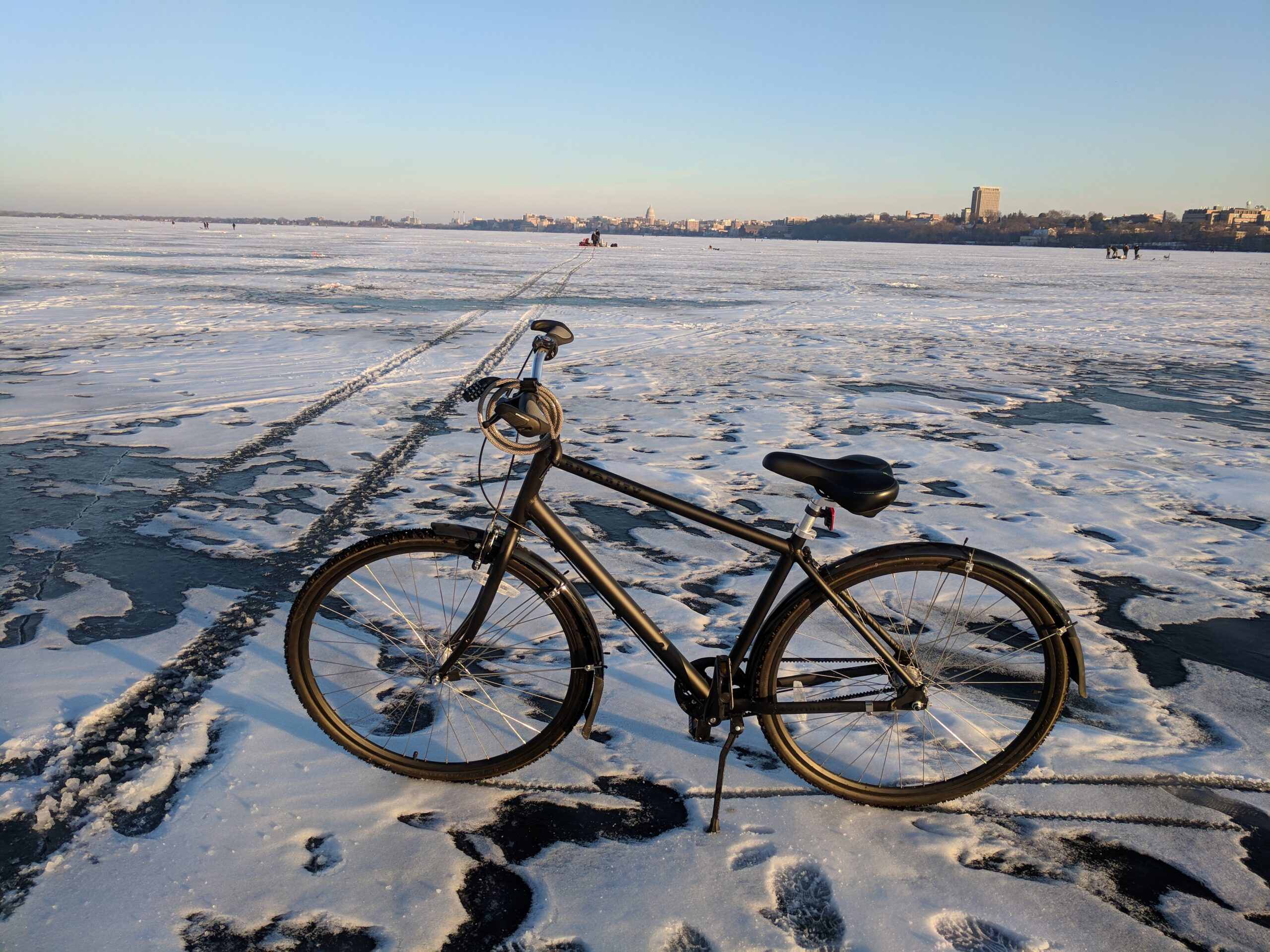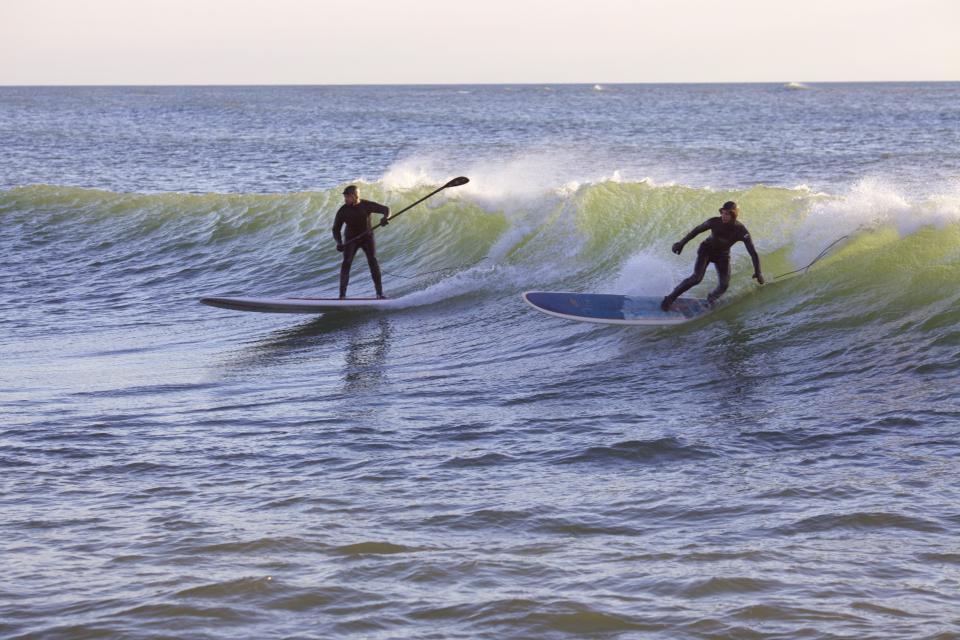The spray of dirty slush, fall-inducing ice and bone-chilling temperatures can make venturing outside treacherous in Wisconsin this time of year — especially on a bicycle.
Yet some hearty folks bike throughout winter and feel rewarded. They save money on parking and bus fare, or get exercise and fresh air.
“I bike because it’s easier than waiting for the bus, or I’m too lazy to walk. And I’m just too cheap to pay for parking,” said Robbie Webber, a board member for the bicycling advocacy group Madison Bikes. “We all live in Wisconsin. We have the clothes to be outside. So instead of scraping the windshield on the car, I just get on my bike.”
News with a little more humanity
WPR’s “Wisconsin Today” newsletter keeps you connected to the state you love without feeling overwhelmed. No paywall. No agenda. No corporate filter.
Webber and Laura Hrubes, a long-distance bike racer from Viroqua, recently appeared on Wisconsin Public Radio’s “The Morning Show” to offer advice on winter bicycling.
Hrubes said Wisconsin winters are too long to stop biking. Having the right biking gear and clothing for a wide range of winter weather conditions is the biggest challenge.
“Winter is such a dynamic thing. You don’t know what you’re going to get from one day to the next,” Hrubes said. “You definitely need to be paying attention and be ready for anything.”
What to wear
Both Webber and Hrubes emphasize the importance of wearing several layers of clothing — just not too many. Riders can overheat when exerting themselves even in the coldest weather.
“I have a jacket that allows me to unzip under my armpits and along my sides to let some air in,” Webber said. “It’s just a shell instead of a big heavy parka.”
She also wears a neck gaiter to “pull up over my nose and mouth so that I don’t breathe cold air.”
Boots, wool socks and well-insulated gloves are essential.
“My mantra with winter biking is ‘keep hands and feet warm.’ That’s the most important thing,” Hrubes said. “Anything that’s a point of contact with the bike you want to be really, really sure is warm and protected.”
Hrubes wears hiking boots a size too big to make room for chemical foot warmers. She places the warmers on the front of her ankles between multiple layers of socks.
On the handlebars of her bike, Hrubes secures pogies — big, insulated sleeves that cover her hands.

What to ride
Hrubes favors her 2021 all-carbon fat bike for racing on snow-packed trails. She significantly reduces the air pressure in the tires to increase traction.
Webber prefers a hybrid commuter bike she’s been riding for at least the past ten winters. She sits more upright on that bike to better observe motorists. The bike also has lights, fenders and at least one studded tire.
“Studded tires are absolutely essential for ice,” Webber said. “Local roads often don’t get plowed well or the snow builds up and it becomes ice.”
Studded tires can cost more than $100 but can also withstand use through multiple winters.
“If your front wheel slips, you’re going to go down. If your rear wheel slips, you can put your foot down and catch yourself. So if you only have one (studded tire), put it on the front wheel,” Webber said.
Bike maintenance
Hrubes and Webber said snow, road grime and salt can take a toll on bikes. Wiping down a bike, including the chain and other moving parts, after every ride will lengthen its lifespan.
They suggested oiling the chain and degreasing the drivetrain regularly. Riders should also have a tool measuring how much the chain has stretched, indicating when it needs replacing. They also urged getting bikes tuned up regularly by a bike mechanic.
READ MORE: Elroy-Sparta State Trail reopens after years of post-flooding repairs

Avoid dangerous cold
Hrubes said she rode in minus-30-degree windchill in December but stayed off the bike during a polar vortex that moved through Wisconsin in 2019.
“You’ve got to be really careful, because it can be a life and death situation … if you make a mistake, there are consequences,” she said. “So you really, truly need to be prepared and to have your gear tested and be ready for it.”
On milder winter days, Webber called riding a bike an easy endeavor.
“You’re out there getting exercise, so you’re happier on those gray days,” Webber said.
Favorite races
Hrubes enjoys fat bike races where participants ride mountain bikes with cartoonishly wide tires, typically 3.7 inches to 5 inches wide.
“In this part of the country, where winter is long and cold and difficult and daylight is scarce, you really have to have some big (events) on your calendar to look forward to, plan for and train for,” she said.
She prefers races like those in Wisconsin’s Fat Bike Triple Crown: The Fat Bike World Championship in New Richmond, Jan. 27-29; U.S. Fat Bike Open in Green Bay, Feb. 11; and the Fat Bike Birkie in Cable, March 11.
These races range from 12 miles to more than 30 miles. A race can take an hour to several hours to complete, depending on weather, snow conditions and other factors.
READ MORE: What’s your preferred bike trail surface: Gravel or pavement?
READ MORE: How The Bicycle Empowered Women
Wisconsin Public Radio, © Copyright 2025, Board of Regents of the University of Wisconsin System and Wisconsin Educational Communications Board.



